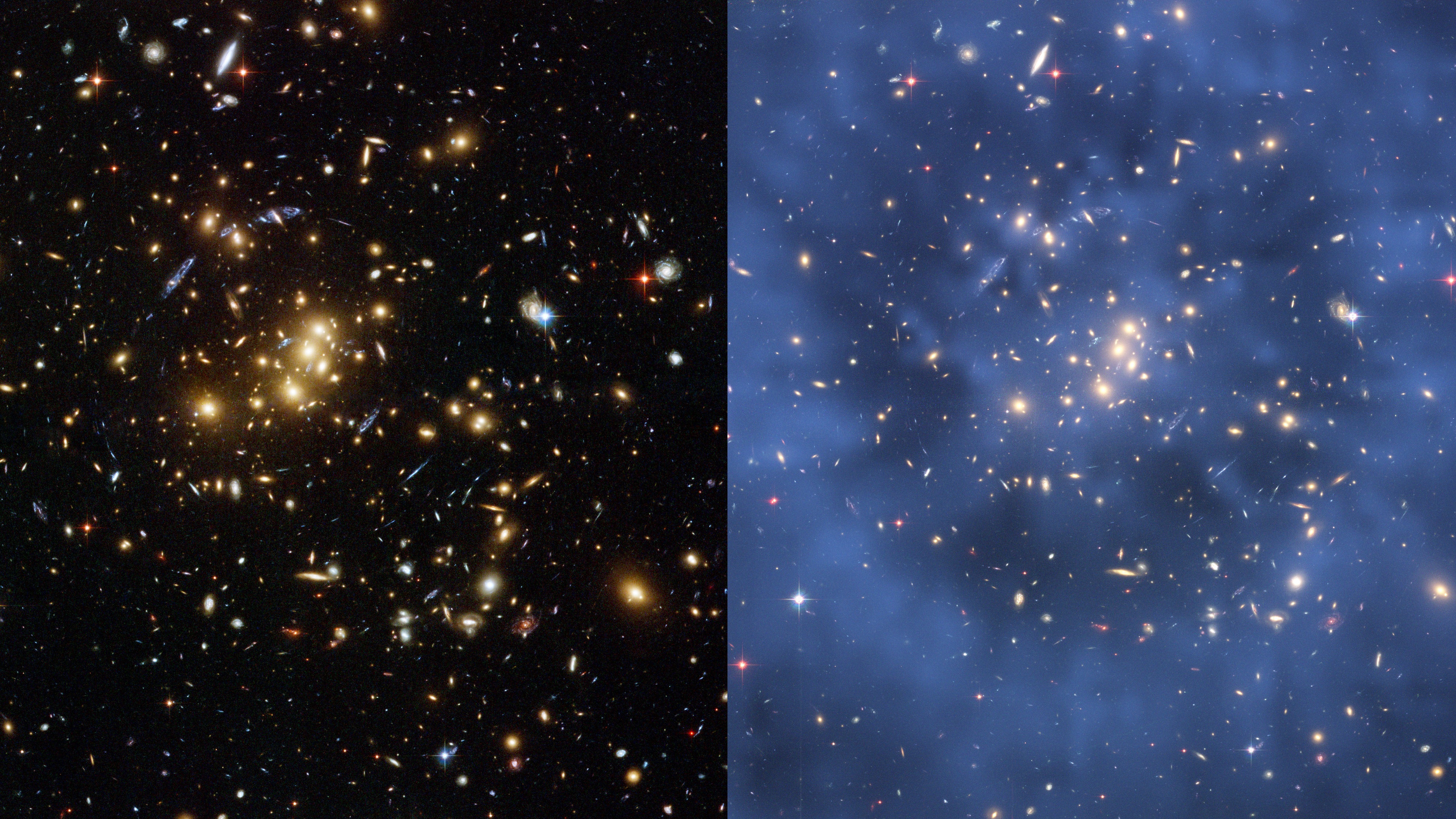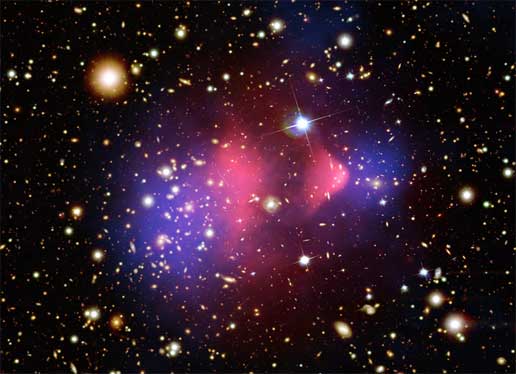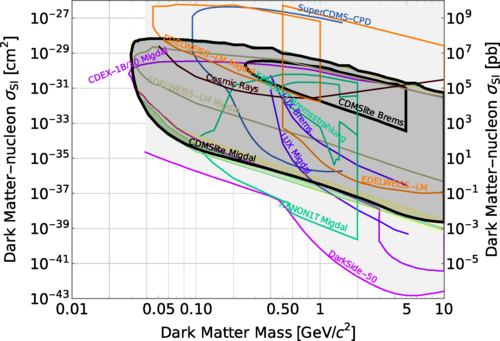We still don't know what dark matter is, but here's what it's not
"It's all about mindset in science, where a null result can be as impactful as a positive result."

The quest to find dark matter is a curious one. It is, quite literally, a shot in the dark. Even though scientists are certain that dark matter exists — as all our universe's normal matter simply can't account for the way galaxies are kind of held together — they don't know what it is. They also don't really know where it is (though they have some ideas). And they definitely don't know what it looks like.
Yet the physics community is keen on investigating these elusive particles because the dark side of our cosmos accounts for an unsettling 95% of our universe when taking into account dark energy, the unseen force accelerating space's expansion.
But how does one analyze something without truly knowing what to analyze? Well, there is one way. Despite not knowing what dark matter is yet, scientists can slowly figure out what it is not.
This is precisely what several researchers who are dedicated to the hunt recently did by sifting through data captured with a detector buried deep within a mine in Minnesota. While they did not find evidence of dark matter, they say they've created one of the tightest-ever limits for detecting the phenomenon someday. A full outline on their findings was published in June in the journal Physical Review D.
"It's all about mindset in science, where a null result can be as impactful as a positive result," Daniel Jardin, study co-author and a postdoctoral scholar at Northwestern University, told Space.com. "Obviously it would have been fantastic to find dark matter, but we managed to rule out a new slice of dark matter parameter space."
Related: 'Hidden' photons could shed light on mysterious dark matter
These latest revelations are associated with the Super Cryogenic Dark Matter Search (SuperCDMS) collaboration, which Jardin is a member of.
Get the Space.com Newsletter
Breaking space news, the latest updates on rocket launches, skywatching events and more!
To put it briefly, SuperCDMS's experimental detector, the team concluded, can now rule out dark matter particles down to about a fifth of a proton's mass — and potentially even lower masses.
"I've always liked chasing the unknown, and that's as big as it gets," Jardin said. "I'm very happy that my career has led me here and, however brief it may last, I can always say this result was the best in the world until other experiments inevitably catch up."

Wait, what is SuperCDMS?
To capture proof of dark matter particles, the SuperCDMS collaboration works with an experiment referred to as, well, SuperCDMS.
This experiment basically harnesses the power of detectors that can identify if and when a dark matter particle (whatever that is) collides with the atomic nuclei of materials built into the detectors themselves, specifically either germanium or silicon.
"I've been interested in space since I was young because it makes everything on Earth feel so small and insignificant," Jardin said. "Then I learned about dark matter and couldn't believe all of the stars and galaxies and things we see in the night sky make up less than 5% of the universe."
Getting even more technical, SuperCDMS can pick out whether those dark matter particles partake in what are known as "elastic collisions." If they do, what would happen is any energy a dark matter particle loses upon its crash would get transferred to the motion of the impacted atomic nucleus. In turn, the two bits would recoil.
As study co-author Noah Kurinsky, a staff scientist at the SLAC National Accelerator Laboratory, puts it, it'd be like two billiard balls smashing into one another only to slightly bounce backward on the table.
But here's the thing.
SuperCDMS clearly hasn't found any elastic collisions yet — per Jardin, we'd have heard about that by now as such a discovery would probably earn a Nobel prize. However, this team of researchers, notably including Rob Calkins, a research assistant professor at Southern Methodist University, came up with an interesting question.
What if SuperCDMS had been capturing some other type of collision no one's been looking for all this time? Particularly, inelastic collisions.
And considering these new results, they were definitely on to something.
"Searching for elastic collisions is still the main thrust of SuperCDMS, but considering inelastic collisions opened an avenue to dark matter parameter space that the experiment was not previously sensitive to," Jardin explained.
There are two ways a potential dark-matter-inelastic collision may work. The first, according to the team, has to do with something called Bremsstrahlung radiation. In the detector, if this type of inelastic collision happened, the dark matter particle would transfer some of its energy to a light particle, or photon, rather than just recoiling like in the billiard ball example.
Though on the other hand, an inelastic collision may occur through something called the Midgal effect. If this version happened, the dark matter particle slamming into the nucleus would cause the nucleus itself to get knocked out of position, messing up its electron cloud distribution. Upon getting back into its original spot, some of those jostled electrons would get ejected.
At risk of simplification, this means the team was searching for SuperCDMS signals of either a flying photon or lonely electron straggler.
"It wasn't as easy as counting," Jardin noted. "This analysis used spectral shapes to model the energy profile of the signal as well as the many known background sources."
And after all that, the search turned up empty — but the story didn't end here.
"Then," Jardin continued, "we used statistics to answer the question 'what is the probability that we see the signal over the known background?' That question is repeated hundreds of thousands of times and we rule out the parameter space where we should've been able to see the signal and didn't."

There's always a silver lining
"There are roughly 1 billion dark matter particles passing through you every second, but they interact so rarely that you can't tell," Jardin said. "We're looking for a 1 in a billion billion billion billion chance of interaction."
Even though that golden ticket was not found, however, other forms of treasure did come to light.
Foremost, all of those statistical studies on SuperCDMS signals ended up providing the team with their conclusion about dark matter particles' likely lower mass limits.
"Another dark matter experiment that wasn't sensitive to dark matter mass as low as SuperCDMS for elastic collisions published a similar analysis that extended their reach and leveled the playing field. Reading that, we wondered how much lower we could reach if we used the same method," Jardin said.
Plus, as he explained, the team also "added more to the analysis such as more complex statistics and the inclusion of interactions with the Earth."
Yes, the Earth
Perhaps even more impressive is how the team took into consideration that the entire Earth's position in space can affect these dark matter signals.
As they explain, if dark matter interacts strongly enough with stuff, it'd likely interact with literally everything in its path on the way to our little Earth-based detectors underground. One of those things ripe for interaction is our planet's atmosphere.
And if a dark matter particle did interact with our atmosphere, this planetary shield would take away some of the particle's energy by the time we captured its signals, the team reasoned.
"Dark matter is believed to be fairly ubiquitous in a big sphere around the galaxy," Jardin said. "Our solar system is in a spiral arm of the Milky Way that is spinning, the Earth is orbiting the sun and the Earth rotates on its axis. This astronomical motion means the Earth is passing through the sea of dark matter particles, but from our perspective, that looks like dark matter particles are constantly bombarding the Earth and our detectors."
Thus, the researchers realized there's likely an upper limit to the energy such reactive dark matter particles can hole — if they are this reactive, that is.
By modeling things like Earth's atmospheric density, working with geologists to figure out what types of rocks are above the Minnesotan mine where SuperCDMS is buried and tons of other variables, they indeed figured out those upper dark matter energy limits.
"When you fit a line to some data, there are 2 parameters: Slope and intercept," Jardin said. "In this analysis, we had over 50 parameters being fit simultaneously."
As for what's next, well, Jardin says this Sherlock Holmes-style deduction shall continue. And if any of that went over your head, he emphasized a visual way to look at the team's results that put everything into perspective.

"This result — the black lines — rules out some new parameter space that others haven't reached before, but there's a lot of open space to the left, representing lower masses and bottom, representing a lower chance of interacting," he said. "Those are increasingly difficult to probe, but dark matter physicists are clever."
These dark matter hunters surely reached for the stars and managed to softly land on the moon.
Join our Space Forums to keep talking space on the latest missions, night sky and more! And if you have a news tip, correction or comment, let us know at: community@space.com.

Monisha Ravisetti is Space.com's Astronomy Editor. She covers black holes, star explosions, gravitational waves, exoplanet discoveries and other enigmas hidden across the fabric of space and time. Previously, she was a science writer at CNET, and before that, reported for The Academic Times. Prior to becoming a writer, she was an immunology researcher at Weill Cornell Medical Center in New York. She graduated from New York University in 2018 with a B.A. in philosophy, physics and chemistry. She spends too much time playing online chess. Her favorite planet is Earth.
-
Questioner ReplyAdmin said:An experimental detector can now rule out dark matter particles down to about a fifth of a proton's mass.
We still don't know what dark matter is, but here's what it's not : Read more -
Questioner Dark matter' is STUPID BS.Reply
Problem 1:
(i repeat)
'dark matter' would have self contradicting properties in terms of gravity.
in a disk galaxy it would have to be in a faucet washer shape.
The outside edge of which is immune to gravity.
Since it doesn't pile up around stars and planets it's immune to gravity again,
BUT when a galaxy orbits another galaxy it does follow THAT curvature of gravity?!?
Problem 2:
When a galaxy orbits another it largely retains its concentricity of form.
The galaxy's central black hole stays in center of hole in the 'dark matter',
which requires a WHOLE NEW FORCE OF PHYSICS!
Mutual repulsion between black holes and 'dark matter'?!?
Problem 3:
The hypothesized quantity of 'dark matter' in virtually every galaxy out there is exactly proportional to the size of its central black hole?!?
One would expect 'dark matter' and central black holes to have reasonable independence from one another.
Relativity does not require mass/matter for curvature/gravity to be present.
ie. de Sitter & Schwarzschild space-times.
Get past Einstein's hang up trying to pin ALL curvature/gravity exclusively on mass/matter. -
danR Reply"There are roughly 1 billion dark matter particles passing through you every second,..."
Is that claim by conjecture or by conclusion?
Without championing recent evidence for Milgrom, et al.'s best MOND variant (I'm sitting on the fence now), I find the article as a whole, and some of the quotes, alarmingly rife with spongy reasoning and glib assumptions. -
Tom C Reply
I thought dark matter had been figured out. When you eliminate everything else, the only thing left is that dark matter must be pure gravity. That would explain its properties.Admin said:An experimental detector can now rule out dark matter particles down to about a fifth of a proton's mass.
We still don't know what dark matter is, but here's what it's not : Read more -
Ryan F. Mercer Reply
Hey danR! I couldn't agree more.danR said:Is that claim by conjecture or by conclusion?
Without championing recent evidence for Milgrom, et al.'s best MOND variant (I'm sitting on the fence now), I find the article as a whole, and some of the quotes, alarmingly rife with spongy reasoning and glib assumptions. -
PaulK I got my BS in Physics 40 years ago but moved on to graduate degrees in Computer Science. So, not pretending to be a real physicist, but I have a pretty good basis.Reply
My daughter is taking a physics course at university and asked me what dark matter is. I'm 40 years out of date so I checked the latest research. It seems exactly what it was 40 years ago. Blind faith in a theoretical construct to support the math without a shred of evidence. That doesn't mean it is "BS" - but maybe we should question our absolute certainty and explore alternative theoretical models? -
Jzz ReplyQuestioner said:Dark matter' is STUPID BS.
The kind of carping that is present in the comments seems to characterize the whole of modern physics: “If you can’t understand something: wing it!” The article I read on the subject stated that about 95% of all matter in the Universe was Dark Matter and Dark energy. It might be possible to dismiss, a few percent of something as being due to faulty reasoning or so but 95%? Surely not.Admin said:An experimental detector can now rule out dark matter particles down to about a fifth of a proton's mass.
At this time I would like to raise what for many must be an unpleasant observation, namely that the properties of Dark matter seem to be identical to that of the discarded and much ridiculed concept of the aether. Dark matter allows the passage of ALL kinds of electromagnetic radiation, without offering the slightest resistance or hindrance to its passage; this is exactly what the aether was supposed to do. Take time to think about this, it is not such a commonplace occurrence, a substance that occupies an amazing 95% of the Universe, allows the free passage of all electromagnetic radiation and gravity also!
Also think about the fact that our earth and our solar system HAVE to lie within that 95% of the Universe that is occupied by Dark Matter and Dark energy, ergo: What we took to be the aether was Dark Matter!
Look at some of the properties of Dark matter: (1) It is absolutely permeable to matter i.e., it can pass through a dense body like the earth or the sun without the slightest interaction and without offering a discernible opposition to its passage (2) the opposite is also true, bodies like the solar system, stars and Galaxies can pass through Dark Matter without experiencing any interaction. (3) It is practically undetectable (just like the aether was) (4) it cannot be weighed (5) it cannot be quantified in any manner whatsoever (6) Its presence can only be inferred by its effects (again just like the aether) (7) it is odourless (8) it is invisible and so on…..
Yet, there are certain things about Dark Matter that we do know. WE KNOW for instance, that it influences gravity WE KNOW that it allows the free passage of all electromagnetic radiation. WE KNOW that it can’t be weighed or quantified. Where does this leave special and general relativity. I’ll tell you: In the Dust!
BUT I feel we are very wrong in inferring by these circumstances that Dark Matter must have a discernible weight, the weight attributed to Dark Matter is far in excess of what it probably is. Can you imagine a Universe that is packed solid with particles that weigh one fifth of a proton! That is a mass equal to that of 400 electrons? Impossible! If you want to know what Dark Matter is and get a handle of how it works. Read my article on The Electromagnetic Universe -
Questioner BS is sometimes how people grapple with things they don't understand or at least haven't figured out all the details. It's also a means of prevaricating &/or obfuscating ignorance by self anointed 'authorities'.Reply
Bluffing when you have no good cards.
Why not call it what it is, namely
Astro Gravity Spackle.
Anywhere there appears to be gravity for no obvious reason trowel on some AGS.
But using any kind of matter would require self-inconsistent properties.
Matter simply doesn't wok, PERIOD.
What are the gravitational & inertia properties of that mythical 'dark matter'?
They are nonsense.
'Dark matter' is illogical. -
Classical Motion Why do we need it? What if our estimates of star velocity is wrong? Can we observe the actual length that the star travels? What if the star is not only moving in and out as it orbits, but also goes up and down while in orbit? This would add length to your time of travel that you would not see. What if the star was in a helical spin as it orbited? That would add un-seen length. And if all the stars were doing this....it would appear as a warpage when viewed edge-on. These un-seen lengths add velocity and momentum to your figures.Reply









